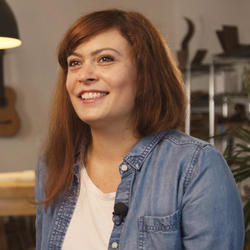Rachel Rosenkrantz
Rachel Rosenkrantz is a master luthier based in Providence, who designs and handcrafts unique stringed instruments. She has also worked for years as a furniture maker and as an industrial designer in the innovation departments of major companies. In the field of lighting, she was instrumental in developing color-changing technology, which is in great use today.
Born and raised in Montfermeil, France, Rosenkrantz studied design at ESAG-Penninghen and at RISD, where she was exposed to both fine art and applied art. Rosenkrantz’s work has been exhibited in Paris at Le Carrousel du Louvre and Le Musée d’art Contemporain du Palais de Tokyo and in Seoul, Korea at the Hangaram Museum of Modern Art. She has presented gallery talks at The Metropolitan Museum of Art and run symposiums, panel discussions and workshops at Parsons and the Worcester Polytechnic Institute, among others. Her work has been featured in Anthony Bourdain’s Raw Craft as well as Autodesk’s Design Mind.
As with her music and design, Rosenkrantz uses luthiery to combine the traditional and the new, exploring new techniques while bringing a unique perspective to a traditional idiom with a strong focus on sustainability and, in particular, biomaterials.
Courses
Fall 2023 Courses
FOUND 1005-24
STUDIO: SPATIAL DYNAMICS
SECTION DESCRIPTION
Studio: Spatial Dynamics is a studio-based inquiry into physical, spatial and temporal phenomena. The study of Spatial Dynamics is rooted in the necessity to consider forces and their effects on structure. Force is the consequence of energy. In Spatial Dynamics the energy and resultant forces are studied in actual motion, stability, and materiality. The structures of physical, spatial and temporal phenomena are studied through additive, subtractive, transformative, iterative, and ephemeral processes both analog and digital. Mediums and materials that are commonly explored and utilized have a broad range of characteristics due to their organic and synthetic sources. Most assignments utilize methods such as preliminary sketches and diagrams in research, planning, and experimental processes. Assignments reference the histories and theories of art and design and include areas of inquiry that extend to disciplines such as the sciences, music, dance, film, and theater.
Enrollment is limited to first-year Undergraduate Students.
Major Requirement | BFA
FOUND 1005-12
STUDIO: SPATIAL DYNAMICS
SECTION DESCRIPTION
Studio: Spatial Dynamics is a studio-based inquiry into physical, spatial and temporal phenomena. The study of Spatial Dynamics is rooted in the necessity to consider forces and their effects on structure. Force is the consequence of energy. In Spatial Dynamics the energy and resultant forces are studied in actual motion, stability, and materiality. The structures of physical, spatial and temporal phenomena are studied through additive, subtractive, transformative, iterative, and ephemeral processes both analog and digital. Mediums and materials that are commonly explored and utilized have a broad range of characteristics due to their organic and synthetic sources. Most assignments utilize methods such as preliminary sketches and diagrams in research, planning, and experimental processes. Assignments reference the histories and theories of art and design and include areas of inquiry that extend to disciplines such as the sciences, music, dance, film, and theater.
Enrollment is limited to first-year Undergraduate Students.
Major Requirement | BFA
Spring 2024 Courses
FOUND 1006-16
STUDIO: SPATIAL DYNAMICS
SECTION DESCRIPTION
Studio: Spatial Dynamics is a studio-based inquiry into physical, spatial and temporal phenomena. The study of Spatial Dynamics is rooted in the necessity to consider forces and their effects on structure. Force is the consequence of energy. In Spatial Dynamics the energy and resultant forces are studied in actual motion, stability, and materiality. The structures of physical, spatial and temporal phenomena are studied through additive, subtractive, transformative, iterative, and ephemeral processes both analog and digital. Mediums and materials that are commonly explored and utilized have a broad range of characteristics due to their organic and synthetic sources. Most assignments utilize methods such as preliminary sketches and diagrams in research, planning, and experimental processes. Assignments reference the histories and theories of art and design and include areas of inquiry that extend to disciplines such as the sciences, music, dance, film, and theater.
Enrollment is limited to first-year undergraduate students.
Major Requirement | BFA
FOUND 1006-20
STUDIO: SPATIAL DYNAMICS
SECTION DESCRIPTION
Studio: Spatial Dynamics is a studio-based inquiry into physical, spatial and temporal phenomena. The study of Spatial Dynamics is rooted in the necessity to consider forces and their effects on structure. Force is the consequence of energy. In Spatial Dynamics the energy and resultant forces are studied in actual motion, stability, and materiality. The structures of physical, spatial and temporal phenomena are studied through additive, subtractive, transformative, iterative, and ephemeral processes both analog and digital. Mediums and materials that are commonly explored and utilized have a broad range of characteristics due to their organic and synthetic sources. Most assignments utilize methods such as preliminary sketches and diagrams in research, planning, and experimental processes. Assignments reference the histories and theories of art and design and include areas of inquiry that extend to disciplines such as the sciences, music, dance, film, and theater.
Enrollment is limited to first-year undergraduate students.
Major Requirement | BFA
